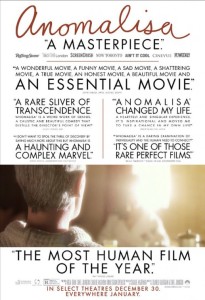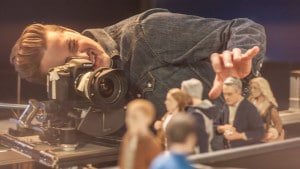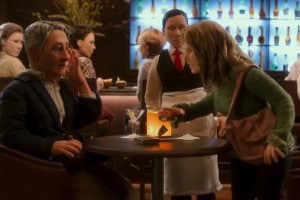Interview with Charlie Kaufman and Duke Johnson, Co-directors of Anomalisa
The Academy Award-nominated Anomalisa (Best Animated Feature) tells the story of Michael Stone (David Thewlis), husband, father, respected author, and a man crippled by what he considers a mundane life. On a business trip to Cincinnati, where he’s scheduled to speak at a convention of customer service professionals, he checks into the Fregoli Hotel. There, he is amazed to discover a possible escape from his desperation in the form of unassuming Akron baked goods sales rep, Lisa (Jennifer Jason Leigh). Profoundly emotional, introspective, and stunning, Anomalisa is a film unlike any you will see this year and certainly one of the best.

The project was originally conceived by Kaufman under a pseudonym and first performed as a “sound” play, back in 2005, starring Jennifer Jason Leigh, Tom Noonan, and David Thewlis (who also lend their voice talents to the theatrical version). The production featured the actors delivering their lines from stools on a barren stage as if recreating an old radio play. Years later, the production company Starburns Industries, Inc. planned to make Anomalisa its first non-television venture and Duke Johnson was chosen to co-direct the film with Kaufman and bring it to life as an animated feature.
Kaufman and Johnson recently spoke with CinemaNerdz and Tom Santilli (my colleague from the Detroit Film Critics Society [DFCS]) from Examiner.com about making Anomalisa, developing the film’s unique animation style, the talented actors showcased in the film, and some surprising audience reactions to the movie. What follows is a transcript of that interview.
EXAMINER.COM: Charlie, a big theme in the movie seems to be an exploration of the Fregoli delusion, is that something that you were familiar with in your personal life, or what made that an interesting affliction to explore?
CHARLIE KAUFMAN: It’s actually not an exploration of that. I used that as a jumping off point, as a metaphor. The character, Michael, doesn’t suffer from Fregoli delusion, but it interested me as a metaphor for someone who can’t connect with people. I don’t suffer from Fregoli delusion. It’s very rare and I don’t know anyone who suffers from it. I feel like if it were to be about Fregoli delusion, the story becomes moot because it’s like, this guy’s got this problem, now let’s just watch it for an hour and a half. But it’s more about what’s wrong in this person’s psyche that they can’t connect with people.

(Charlie starts to laugh and Duke grimaces)
DUKE JOHNSON: Just to clarify, I’m not an animator and also, there’s a common misconception that I was sort of in charge of the animation portion and Charlie was maybe in charge of the….
KAUFMAN: I was just off in the corner fretting.
JOHNSON: We actually split the duties right down the middle.
KAUFMAN: Not even down the middle, we did everything together.
JOHNSON: Does that not mean the same thing?
KAUFMAN: No, because split down the middle means you did this, and I did that. But we are the directors of the movie. We made decisions together as a team.
JOHNSON: Some of the challenges particular to this project [included] trying to achieve a more authentic style of animation. An authentically emotional style of animation that I had not attempted in my previous animation work. I’d been working in animated television and it’s broader and more archetypal gesturing and pantomime kind of stuff. There’s a different intention with those things. This is something different. I’ve never seen anything like this before. We kind of created our own thing. When you do that, you have to figure out how to do that. It posed a lot of problems. I’m sorry I’m fumbling but there’s like a thousand things that I could say to answer that question.
EXAMINER.COM: Kind of on that topic, I heard that this movie ended up very similar to the original script that was used in the audio play. In particular, what sequences did you find the most challenging to adapt? Was there anything that became more challenging once you got to the point of making it a feature?
JOHNSON: Anything that’s visual in nature, like purely visual, was added because the stage performance was just all audio and dialogue based. So all the visuals were intended for the audience to have in their minds. So once it became a visual thing, we had to decide what all those visual things would be. Not just the stuff that’s written about in the script, which is there, but also things that are purely not alluded to in the screenplay. I’m scared to say specifically what they are because I don’t want to give anything away. There’s visual things in the movie that were not in the script. Challenges that arose when translating it to a visual are like for example, the sex scene. That existed in the play, but it was two actors on a stage moaning and now we had to decide what that looks like.

JOHNSON: Yeah, what was causing them to moan.
CinemaNerdz.com: Charlie, did you know from the start that you were going to keep the same cast as the play? And I apologize if you both made that decision.
JOHNSON: (Both laughing) Don’t be gun shy.
KAUFMAN: I knew I wanted to. And I approached them and they agreed to do it. So, yeah, they were all very happy to do it. I’m not sure I would have wanted to go ahead if I couldn’t get them. It was an experience that we shared in 2005 and we really enjoyed doing it and I wanted to have a continuation of that.
EXAMINER.COM: Charlie, as far as this whole press tour goes, I know that tonight you are both doing a Q&A with a live audience after a screening of the movie, what do you like about that kind of audience and reaction? What’s in it for you and what do you take out of those kinds of experiences with the audience?
KAUFMAN: I like when people express what the movie’s about. Often that starts with them asking us what it’s about and we tell them we’re not answering that question because it’s their movie and it’s for them to react to. And if that starts a conversation with the audience those are the most fun for me. I really enjoy hearing what people think about it and how it’s affected them.

JOHNSON: Yeah, I feel the same way. It’s very satisfying to get the audience reaction, having them feel like it meant something specific to them. Sometimes they’re very passionate about it, about what it meant to them. I think that’s great.
CinemaNerdz.com: Have there been any surprising responses to the film?
JOHNSON: I guess at one point they were all kind of surprising. The first time you see it with an audience, you’re hoping that they’re going to laugh at certain parts so it was surprising to me in a good way that things seemed to work in the way that we intended. But, certainly people have come to us with interpretations of aspects of the film that never occurred to me. So those were surprises for sure. That doesn’t make them incorrect either, by the way.
KAUFMAN: No, they can’t be incorrect. There’s no way to be incorrect in interpreting this movie.
EXAMINER.COM: We kind of hit on this a little bit earlier, but I wanted to ask in more detail about the animation style. How did you guys come up with this very realistic animated stop-motion style? Were there any other visions in your head as to the kind of style that this could have been and why did you arrive at what it ultimately ended up being?
KAUFMAN: I don’t think there was ever a point where we were talking about making this cartoony. The story doesn’t lend itself to that. The fact that we wanted an emotional interaction with an adult audience doesn’t lend itself to that choice. The specifics of what it looks like came about over time through trial and error and talking to designers and figuring out the best way to approach character development and character design. But I think, as far back as I can remember this was never going to look like The Nightmare Before Christmas or anything. That wasn’t our interest.
JOHNSON: It did evolve slowly over time. It’s not like we had a clear vision of this is what we wanted it to look like and then we went about achieving it. It was more like we wanted it to feel authentic. We recorded the voices first. That’s the first thing we did. That sort of set the tone for things. And then we were like, how can we get the broadest range of emotional expressions in the faces and that led us to the style of replacement animation. We want it to look real but we don’t want them to feel dead and have that uncanny valley feeling so that led us towards the eyes and trying to find ways to make the eyes feel soulful and alive and articulate. Each kind of step in the process led us to a new discovery. Some discoveries we embraced and encouraged and they led to other discoveries and that’s how they came about.
CinemaNerdz.com: We were discussing the look of the puppets earlier and in particular the scene where the faceplate falls off of the Michael character. I had read somewhere that that was an accident during pre-production or filming….

JOHNSON: This is not the first time we’ve heard somebody in an interview say that to us, so I wonder who wrote that.
KAUFMAN: What we have said, and that may be what the confusion is, is that when his face starts to go haywire in the mirror, that was based on some camera or character tests we did, where we were watching them sequence and it was very creepy looking and we decided to incorporate that. But we didn’t use that; we redid it for that scene.
JOHNSON: It was a discovery, not an accident. It might be somebody hypothesizing that it was an accident. We heard the other day that somebody said that these were human bodies with masks.
KAUFMAN: I don’t think they move like actual humans but I do sort of take that as a compliment, that they would think that.
CinemaNerdz.com: It is unsettling for maybe 5-10 minutes before you get into the look and feel of the movie.
KAUFMAN: Yeah.
EXAMINER.COM: I’m just curious in terms of the direction of the voice, audio portion of the film, how was that process working with the actors? Obviously these people had done this prior before. Was it like you were all already on the same page with everything as far as what you were trying to get across in the voice performances. What was the process with the actors?
KAUFMAN: There was certainly an advantage. At that point, it was six years since we had done it as a play. So, they had to re-familiarize themselves with the material. And I think the main thing that we did with the actors was bring it down to a more intimate sort of level. Which I think instinctively they would have done anyway but it was a theatrical performance, it was interacting with the audience, which was laughing, and all of that stuff went away when we were sitting in a studio together. We worked with them all together. It was done as a play in chronological order with them in the studio, which is an unusual thing for animation. They’re very good actors so they don’t need a lot of direction.
EXAMINER.COM: I want to end with one quick question. I know no filmmakers set out for critical acclaim but this movie has obviously gotten a lot of critical attention and we’re on the verge of the Oscar nominations. Would a nomination from the Academy, be something that in any way would validate, how would it make you both feel to be honored in that way?
KAUFMAN: Anomalisanation. (Everyone laughs.) It helps the movie. It helps us get people to come and see the movie. So in that sense it would be good for us.
JOHNSON: Yeah, absolutely. I think on a certain level, it’s a validation that people are responding to the movie and that’s a good thing.
See the Academy Award-nominated Anomalisa directed by
Charlie Kaufman and Duke Johnson in theaters on Friday, January 15, 2016!
The complete audio of this interview will appear on an
upcoming episode of the DFCS podcast, Far From Hollywood.
Mike Tyrkus
Latest posts by Mike Tyrkus (see all)
- Box-Office Weekend: Civil War Stays on Top - April 21, 2024
- Box-Office Weekend: Civil War Bests Monsters - April 14, 2024
- Box-Office Weekend: Godzilla and Kong Still Kings - April 7, 2024


